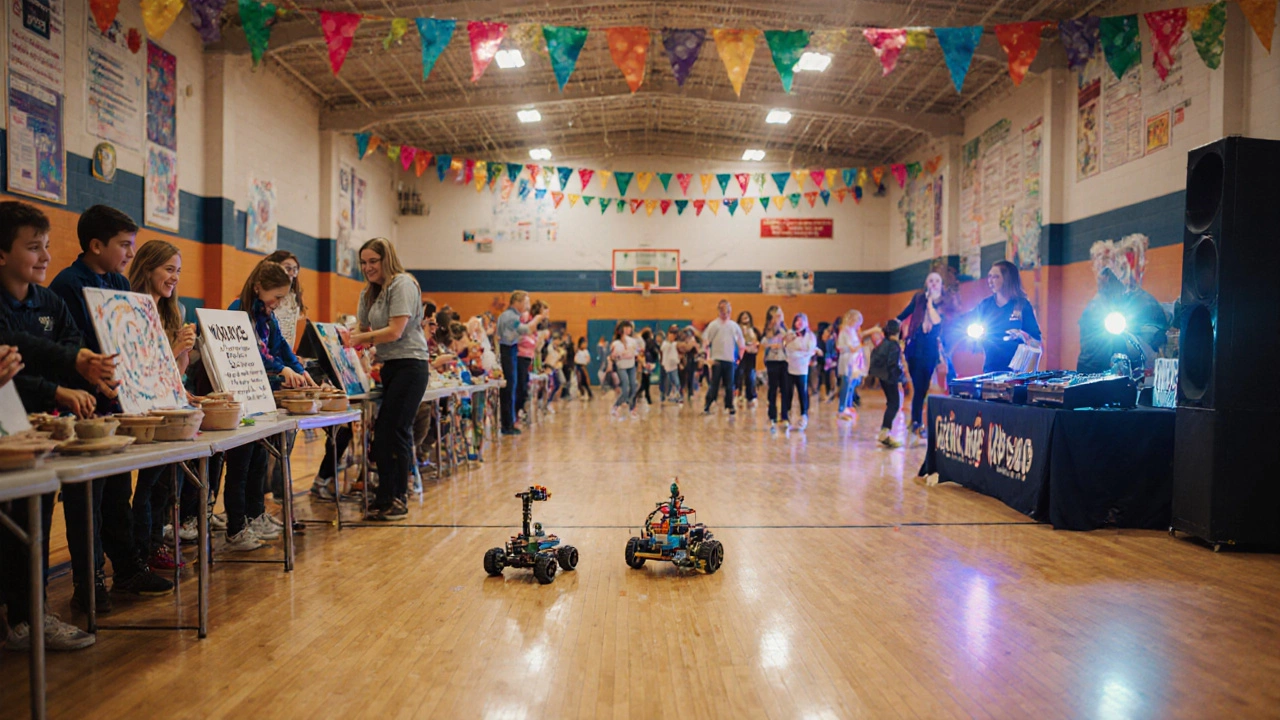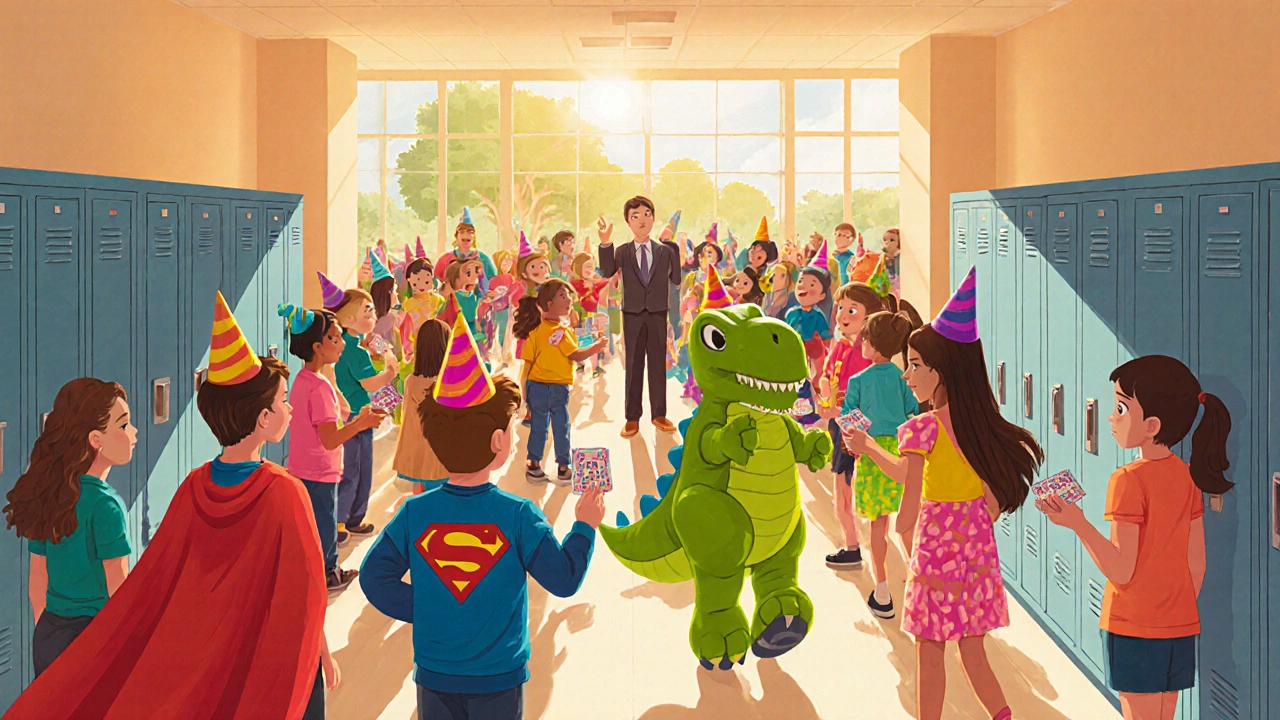Wacky Day Budget Estimator
Estimate Your Wacky Day Budget
Calculate your estimated budget based on your school's size and activity needs. This tool helps you plan for decorations, prizes, and other essentials based on school event standards.
When you hear Wacky Day, you probably picture students in goofy outfits, teachers playing games, and a cafeteria buzzing with laughter. But what exactly is this day, how does it fit into the school calendar, and why should after‑school clubs care? Below we break down the whole concept, from its origins to practical tips for running a memorable event.
Defining Wacky Day
Wacky Day is a school‑wide celebration that encourages creativity, humor, and community participation. It typically takes place once a year, often in the fall, and invites students, faculty, and parents to step out of the routine and enjoy light‑hearted activities. The intent is not just giggles; schools use the day to strengthen school spirit, boost attendance at after‑school clubs, and raise modest funds for student projects.
How Wacky Day Originated
The idea traces back to the 1970s in the United States, when teachers sought a break from the pressure of standardized testing. Early versions were called "Silly Saturday" or "Goofy Gala" and were organized by student councils. Over the decades, the concept spread to the UK, Canada, and Australia, adapting to local cultures while keeping the core goal: a fun, inclusive break from the academic grind.
Key Players and Their Roles
- Student Council coordinates the theme, ticket sales, and promotional posters
- After‑school clubs run activity stations such as robotics demos, art crafts, or sports challenges
- Teachers serve as judges for costume contests and host classroom games
- Parent volunteers help set up booths, manage crowds, and provide snacks
- School administration gives final approval, ensures safety protocols, and allocates budget
Typical Schedule of a Wacky Day
- Morning kickoff (8:30am): Principal’s brief speech, theme reveal, and distribution of “wacky tickets.”
- Classroom challenges (9:00am-10:30am): Each class tackles a silly quiz, rapid‑fire riddles, or a “paper‑plane engineering” contest.
- Club showcase (11:00am-12:30pm): After‑school clubs open booths. Examples include a LEGO robotics demo, a pottery spin‑wheel, and a dance‑off arena.
- Lunch break (12:30pm-1:30pm): Cafeteria serves “fun food” like pizza with smiley‑face toppings and rainbow smoothies.
- Afternoon parade (2:00pm-3:00pm): Students march in costume, cheering each other and displaying club banners.
- Grand finale (3:30pm-4:00pm): Awards ceremony for best costume, most creative club booth, and highest “wacky ticket” collector.

Why After‑School Clubs Should Embrace Wacky Day
Clubs often struggle with recruitment during the busy school year. Wacky Day provides a built‑in audience and a chance to showcase what they do in a low‑pressure environment. Here are three concrete benefits:
- Visibility: A booth near the cafeteria gets foot traffic of over 500 students, far more than a typical club meeting.
- Member engagement: Planning a game or demo forces members to collaborate, strengthening teamwork.
- Fundraising boost: Selling small tokens (e.g., glow‑in‑the‑dark stickers) can generate extra cash for equipment.
Planning Checklist for Organizers
Use this step‑by‑step list to keep everything on track.
- Choose a theme (e.g., "Retro 80s," "Superhero Mash‑up," or "Outer Space").
- Set a date at least six weeks ahead; avoid exam weeks.
- Reserve the gym, cafeteria, and outdoor field.
- Recruit a core committee: two student leaders, one teacher advisor, and three parent volunteers.
- Create a budget: allocate $500 for decorations, $200 for prizes, and $100 for marketing.
- Invite after‑school clubs to submit activity proposals two weeks before the event.
- Design and print flyers; post them on notice boards and share digitally.
- Arrange safety measures: first‑aid station, clear exit routes, and allergy‑free snack options.
- Confirm volunteer shifts and run a brief rehearsal the morning of the event.
- After the day, gather feedback via a short online survey for continuous improvement.
Comparison: Wacky Day vs. Other School Events
| Feature | Wacky Day | Spirit Week | Science Fair |
|---|---|---|---|
| Primary goal | Fun, community bonding | School pride, themed days | Academic showcase |
| Typical participants | All students, teachers, parents | Students and staff (dress-up) | Science clubs, senior projects |
| Club involvement | High - booths & demos | Low - optional displays | Medium - project presentations |
| Fundraising potential | Medium - ticket sales, merch | Low - mostly voluntary | Low - often free entry |
| Time commitment | One full school day | One week (short daily themes) | Multiple weeks of prep, 1‑2hrs showcase |
Real‑World Success Stories
Case Study 1 - Lincoln Middle School (2023): The school introduced a "Mystery Masquerade" Wacky Day. After‑school clubs contributed 12 booths, ranging from a Minecraft building challenge to a jazz improvisation station. Attendance reached 94% of the student body, and the club fund‑raising goal was exceeded by 27%.
Case Study 2 - Greenfield High (2024): By partnering with local businesses, the school offered free craft kits for each participant. The art club saw a 40% spike in new members the following semester, directly linked to the enthusiastic response on Wacky Day.

Common Pitfalls and How to Avoid Them
- Over‑complicating the theme: Stick to a simple, recognizable idea. Too many sub‑themes confuse participants.
- Insufficient volunteers: Plan for at least one adult per 20 students in high‑traffic areas.
- Ignoring accessibility: Make sure activities are inclusive for students with mobility or sensory needs.
- Last‑minute marketing: Start promotion early; use both physical flyers and digital newsletters.
- Unsafe food choices: Offer at least two allergen‑free snack options to avoid health issues.
Step‑by‑Step Guide to Run Your First Wacky Day
Follow this roadmap if you’re new to event planning.
- Form a planning committee. Choose members who represent diverse clubs.
- Survey students for theme ideas. Use a quick Google Form; pick the top three.
- Draft a timeline. Mark deadlines for budget approval, vendor contracts, and publicity.
- Secure sponsors. Local businesses often donate prizes or snacks in exchange for logo placement.
- Design activity stations. Each club creates a 15‑minute interactive demo that aligns with the theme.
- Prepare logistics. Arrange tables, chairs, power strips, and signage.
- Run a rehearsal. Test audio‑visual equipment and walk‑through the flow with volunteers.
- Execute the day. Keep a master schedule on a clipboard; assign a point person for each area.
- Collect feedback. Hand out short paper surveys; analyze responses within a week.
- Report results. Share attendance numbers, funds raised, and next steps with the school community.
Future Trends: What’s Next for Wacky Day?
With digital natives in classrooms, schools are experimenting with hybrid elements. Virtual reality (VR) booths let students explore a “Space Station” theme without leaving the gym. Some districts are adding a sustainability angle, requiring each activity to use recycled materials. Watching these trends can help clubs stay ahead and keep the event fresh year after year.
Frequently Asked Questions
When is the best time of year to hold Wacky Day?
Early to mid‑fall works best because students are settled after summer, weather is mild for outdoor activities, and it avoids the high‑stakes testing period in spring.
How much money should a school allocate for Wacky Day?
Budgets vary, but a range of $800‑$1,200 covers decorations, basic prizes, and promotional materials. Clubs can offset costs through small sponsorships or ticket sales.
Can Wacky Day be inclusive for students with special needs?
Absolutely. Design activities with multiple sensory levels, provide clear visual schedules, and ensure wheelchair‑accessible pathways. Involve the special‑education department early in planning.
What are some low‑cost activity ideas for clubs?
DIY slime stations, paper‑plane contests, speed‑drawing challenges, or a quick coding puzzle using free online platforms. All require minimal supplies and high engagement.
How do we measure the success of Wacky Day?
Track attendance percentages, funds raised, new club sign‑ups, and post‑event survey scores. Combine quantitative data with qualitative comments for a full picture.
